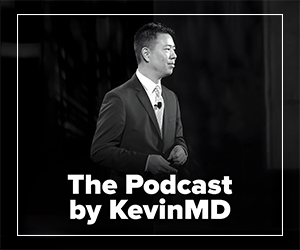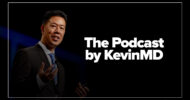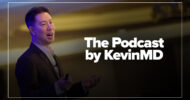Subscribe to The Podcast by KevinMD. Watch on YouTube. Catch up on old episodes!
Pediatrician Gary Kirkilas discusses his article, “Cannabis advertising takes a page from the tobacco playbook.” In this conversation, Gary explains how legal cannabis companies are adopting tactics once used by tobacco companies to target young users, drawing parallels between historical cigarette advertising and current cannabis marketing practices. He highlights the significant health risks of early cannabis use, including memory impairment and negative mental health outcomes, and calls for stricter regulations to protect children and prevent a new smoking epidemic.
Our presenting sponsor is DAX Copilot by Microsoft.
DAX Copilot, by Microsoft, is your AI assistant for automated clinical documentation and workflows. DAX Copilot allows physicians to do more with less and turn their words into a powerful productivity tool. DAX Copilot automates clinical documentation—making it available in the EHR within minutes—and clinical workflows, including referral letters, after-visit summaries, style and formatting customizations, and more.
70 percent of physicians who use DAX Copilot say it improves their work-life balance while reducing feelings of burnout and fatigue. Patients love it too! 93 percent of patients say their physician is more personable and conversational, and 75 percent of physicians say it improves patient experiences.
Discover AI-powered solutions for clinical documentation and workflows. Click here to see a 12-minute DAX Copilot demo.
VISIT SPONSOR → https://aka.ms/kevinmd
SUBSCRIBE TO THE PODCAST → https://www.kevinmd.com/podcast
RECOMMENDED BY KEVINMD → https://www.kevinmd.com/recommended
GET CME FOR THIS EPISODE → https://www.kevinmd.com/cme
I’m partnering with Learner+ to offer clinicians access to an AI-powered reflective portfolio that rewards CME/CE credits from meaningful reflections. Find out more: https://www.kevinmd.com/learnerplus
Transcript
Kevin Pho: Hi, and welcome to the show. Subscribe at KevinMD.com/podcast. Today, we welcome Gary Kirkilas. He’s a pediatrician. Today’s KevinMD article is “Cannabis advertising takes a page from the tobacco playbook.”
Kevin Pho: Gary, welcome to the show.
Gary Kirkilas: Thank you for having me.
Kevin Pho: All right. So before talking about the article itself, tell me your interests in cannabis advertising. Tell us the context that led you to write this article.
Gary Kirkilas: Yeah, so as a pediatrician, I have a fairly unique practice. Most of us as physicians work in traditional brick-and-mortar buildings. I have a pretty unique job out of Phoenix, where I drive a mobile medical unit. And so, we drive these to shelters, group homes, and schools where the majority of the kids are below the poverty line. I’ve got to tell you, I’ve seen a great change in this population—and in other demographics, other socioeconomic demographics—regarding perceptions of what cannabis is.
When I’m talking to my teenage patients, if I ask them about methamphetamines or crack cocaine, I get grimacing faces, and they say, “Oh, that stuff’s horrible.” But when I talk about cannabis, it’s quite a different story. I noticed this in my practice—just progressively, how populations have changed their view of cannabis. And I started to look: Why? Why is this? Why do people feel this way? There are a variety of reasons, but a lot of it has to do with the way cannabis is advertised, particularly if you’re in a state that has legalized it. That really piqued my interest: How do we advertise cannabis? What are public perceptions? Does it have any effect on any of our youth? And so that kind of just led me down a rabbit hole. Here I am now, knee-deep in cannabis policy, et cetera.
Kevin Pho: All right, so tell us about the article itself, “Cannabis advertising takes a page from the tobacco playbook.” What’s this about for those who didn’t get a chance to read the article?
Gary Kirkilas: Sure. I think many of us who grew up will recognize or remember Camel Joe cigarettes—a cartoon used to sell cigarettes. Some of us may even remember back in the 1940s and 1950s how Camel cigarettes would often depict physicians saying, “More doctors smoke Camel cigarettes than any other,” or they might have these confabulated health claims, like having an ENT doc say, “Not a single case of throat irritation with Camel cigarettes.”
Looking back on that, to our eyes and ears now, it’s kind of a weird thing to hear doctors promoting cigarettes. But when I take a look at how the tobacco industry used cartoons—how a lot of their advertisements targeted youth, how they made these questionable health claims—it’s very eerie because I’m seeing a lot of the same step-by-step approaches with cannabis. It kind of just happened organically; I noticed it in my state of Arizona. Every December, we’ll see a billboard of a Santa Claus smoking a joint and saying something like, “Happy holiday blaze,” or “Santa knows where to get his dopest gifts.” I was just wondering, how could that be?
Doing the research, looking back, it’s basically the same steps. Everything that tobacco has done—a very schematic, stepwise approach—cannabis does. And it makes sense. If you look back prior to the 1920s and 1930s, smoking cigarettes was a very fringe market—guys in bowling alleys and mechanic shops. But as a result of a very targeted and systematic approach by the tobacco industry, everybody started smoking. Moms would smoke; doctors smoked. You smoked in boarding and boardroom meetings. You smoked on airplanes. It just exploded. I fear that cannabis is doing the same thing in that same stepwise approach, where they first target health concerns, then they target youth, they make sure it’s cool, and it goes on from there.
Kevin Pho: So just for those who don’t know, what are some of the health risks of cannabis, especially in your pediatric population?
Gary Kirkilas: Anytime you’re smoking any plant, it’s not good for you. Most states, in their attempt to legalize cannabis for recreational use, first went down the path of “This is medicinal,” which is kind of odd because we already have things like Marinol and Epidiolex, but I’ll leave that discussion for another time. In that approach to have it as “medicinal,” it’s just weird to me to think of smoking anything as a medicine.
So, to answer your question, that’s my first step: thinking about the fact that, in some cases, this is considered medicine. I’m no expert in cannabis—potentially, there are very good uses—but first thing, it behooves all of us to remember that we’re sometimes talking about something that’s considered “medicine.”
But as a pediatrician, we’re seeing more and more cases of cannabis-induced psychosis. We’re also seeing many more cases of cannabis-induced hyperemesis. And then we’re getting a whole lot of either purposeful or accidental ingestions by children. A lot of this makes sense because, you know, the cannabis that many of us think about—like the cannabis of the Woodstock era or the 1980s—that’s 2 or 3 percent THC, producing mild euphoria. That’s not what’s being sold in stores now. It’s up to 30 percent THC in the actual bud or flower, and then concentrates can be up to 100 percent. A lot of these gummies will have 10 milligrams of THC in them, and people can get themselves in trouble.
Essentially, the supercharged THC is wreaking havoc on us. It’s completely unnatural—it was never meant for human consumption. So it’s not surprising that we’ve seen these things like hyperemesis and psychosis. Personally, we have patients who get into their parents’ gummies all the time, or teenagers over-consuming cannabis gummies because they don’t really know what they’re doing. It’s easy for them to do so because, when you think about smoking a joint, you know what you’re doing: you can smell it, it’s a very visceral experience, and you’re probably not going to smoke two or three more joints in one sitting. With gummies, it takes longer for the THC to have an effect. So, a new user might take one gummy, wait 15 minutes, not feel anything, then take two or three more. Now they’re in five-joints-worth of THC, and they end up in the emergency room with hyperemesis or nausea, vomiting, et cetera.
Kevin Pho: So how easy or difficult is it for the pediatric population, the teenage population, to access these gummies or other cannabis-related products?
Gary Kirkilas: It’s actually fairly easy. The gummies themselves, thankfully, are only being sold in dispensaries, but all it takes is one person who’s 21, either a peer or a friend, and then instantly anyone below 21 has access to this. Prior to legalization, most cannabis was available as flower, which, again, is a very visceral experience—people know what they’re doing. But once you had legalization, all these more youth-targeted approaches—like flavored gummies, cookies, pizza, et cetera, that’s infused with THC—became available to children.
Kevin Pho: And in terms of who’s doing the advertising, are there products themselves that you feel explicitly follow that tobacco-style playbook?
Gary Kirkilas: Absolutely. Like I mentioned, every December we see Santa Claus smoking joints. Social media is another interesting aspect. A lot of my patients have shown me Instagram posts, and very cleverly, Twitter (or X) is the only platform that allows paid advertisements. However, on Facebook and Instagram, these dispensaries or brands can pump out posts constantly all day long. They are not paid advertisements; they simply have to have in their bio, “Nothing for sale,” although it’s obvious—what else would a company be doing when they’re producing posts? And many of these posts are just as egregious.
You’ll see things like cartoons and free giveaways. A colleague of mine just showed me a hemp-infused beverage ad that had a bunch of teens sitting on a stairwell of their school. It said “School’s out,” and had the word “school” next to a euphemism for getting high. It’s quite egregious. They know they’re targeting the youth market, and it makes sense because if you target 40- or 50-year-olds, you only have them as a consumer for a decade or two. But if you target youth, then you have decades’ worth of a committed user.
Kevin Pho: Again, for those who aren’t aware, tell us about the potential habit-forming properties that cannabis-related products have.
Gary Kirkilas: A decade ago, when this topic came up, no one really talked about cannabis being habit-forming. Everyone’s mind was kind of centered around opioids, and yes, opioids have a very clear, distinct addiction pattern—both mentally and physiologically, they are 100 percent addictive. But as we learn more, we’re also learning things like gaming, sexual activity, all these other things that produce dopamine, can be habit-forming and have addictive properties as well. I have patients who, every morning before they go to school, will vape. They’ll vape during class, during lunch, and they can’t get through a day without doing it.
Especially when you tie that with a youth who has a mental health disorder like depression or anxiety, it’s a lot different than your typical student who’s using cannabis as a social lubricant on the weekends—hanging out with friends, getting high, or hanging out with friends drinking. If you have a youth who’s struggling with PTSD or anxiety, those are chronic illnesses. Cannabis is hitching a ride every day that child experiences anxiety or depression. That goes a long way toward persistent use.
Kevin Pho: And when you talk to your pediatric or teenage patients and explain the potential health risks of cannabis, do they have any insight about it, or is it a complete shock to them when you first bring it up?
Gary Kirkilas: Yeah, that’s a really great question. That’s kind of, again, why I’m in this fight, because youth do not see it that way. If you ask them about methamphetamines, they see that as something very dangerous. Cannabis is completely opposite to them, and this is not just my anecdotal experience. Every year, we have the Monitoring the Future survey out of the University of Michigan that tracks youth’s perception of risk of using cannabis. In the 1970s, essentially no one thought cannabis use was dangerous. Then, as we went through the 1980s and 1990s, it increased, where more and more people were being educated and saw cannabis use as something potentially dangerous. Now we’re right back to the levels of the 1970s, where most youth simply do not see it as something that’s dangerous.
It makes sense. If you see something that perhaps your siblings are using, your parents are using, if you see billboards—especially if they contain cartoons—who blames them? Of course you’re going to think this thing is harmless if it’s readily legalized, readily used, and readily advertised.
Kevin Pho: What are some paths forward? I can think of things like regulating cannabis advertising or perhaps the health profession promoting a counter-narrative that highlights some of the health risks of cannabis. What are some approaches you see going forward?
Gary Kirkilas: One thing I’ve been involved in is essentially trying to change the law—changing cannabis to health policy. Whatever tobacco is allowed to do, cannabis should be allowed to do, or something close to it. I thought when I got into this, it would be a pretty easy, common-sense sort of solution: “You can sell your products legally, but don’t use cartoons. Don’t advertise near schools. Don’t target youth.” That was back in 2021. I worked with a legislator here in Arizona, and the bill just died. We tried again the next year; the bill died again. We tried last year in 2023; the bill died. The enemies of this come out of the woodwork. It’s very, very difficult to pass any common-sense cannabis law to change this.
It depends on which state. If you’re in a state like Arizona, like me, we legalized cannabis via voter initiative. Those are very difficult to modify. However, if you’re from a state where they legalized cannabis in a traditional legislative bill, then it’s a little easier to make amendments. The issue is that to make a bill or create a voter initiative is very expensive—you need a lot of resources—so typically the dispensaries themselves are the ones pushing these through, because they stand to make a profit. They’re not going to self-include restrictions like not advertising or not using cartoons. They want to allow themselves the most.
It takes people like us—physicians, public health experts, teachers, parents—to urge our legislators to do something about it. When you compare all the states, many will have some sort of language like, “You can’t target youth,” but when you look at the nitty-gritty, there’s nothing about banning cartoons or advertising near schools. In reality, the United States is doing a very poor job, and we are essentially repeating the mistakes we did with tobacco.
Kevin Pho: Other than the legislative route, is there anything else our public health officials or physicians can do?
Gary Kirkilas: I would just urge, especially if you’re a primary care physician—a family doc or a pediatrician—to have those conversations, especially with youth. Just ask them. It doesn’t have to be an interrogative process. Say, “I know a lot of youth are using. I just want to let you know there actually are really bad things that can happen when you use this.” You can mention things like hyperemesis or psychosis. Have a very frank discussion. Say, “Look, the cannabis that’s available out there today is supercharged. It has a lot of THC in it. It’s really messing with our brains and our guts. It’s not the best thing to be using. I know people think it’s the greatest thing in the world, but I want to caution you—smoking anything is bad for your lungs, whether it’s tobacco or marijuana, and you shouldn’t consume it as a gummy either, because that THC can really mess with your brain.”
Kevin Pho: We’re talking to Gary Kirkilas. He’s a pediatrician. Today’s KevinMD article is “Cannabis advertising takes a page from the tobacco playbook.” What do you see in the coming years if cannabis advertising continues to follow tobacco’s path? What do you anticipate assuming we can’t get any legislative solutions?
Gary Kirkilas: I hope not, but I think another smoking epidemic is going to occur. If we look at what happened with tobacco—again, a fringe market initially, and then a very targeted systematic approach to increasing youth use by addressing health concerns, having doctors depicted, targeting youth with cartoons—the amount of people who smoked skyrocketed. I fear the amount of people who smoke cannabis will skyrocket, and then we’ll have another smoking epidemic. That’s what I fear.
I hope it doesn’t pan out that way. I hope we learn from our mistakes and have a concentrated health effort. Some people say maybe when it becomes legal federally, we’ll take better approaches. I’m not sure. My fear is that, when it becomes legal federally, a lot of the big industries—especially tobacco—will get involved, and all this mom-and-pop-type advertising we see from individual store owners will increase on a national scale, making it worse. I suspect we’ll probably have some degree of a smoking epidemic with cannabis, and things might get worse before they get better.
A newer thing that’s coming out is hemp-infused beverages. The thing with alcohol is it brings people together—people come together and enjoy a glass of wine or cocktails. You can’t really do that with cannabis, so the industry realizes this, and they want to have THC-infused beverages so people can gather around and consume. That’s the bigger push we’re seeing now. So we’re kind of getting it on all sides. I’m hoping that podcasts like this and people becoming aware of the issue might prevent us from going down that same road.
Kevin Pho: Let’s end with your take-home messages to the KevinMD audience.
Gary Kirkilas: I would just say that if you’re a provider in any capacity, have honest discussions with your patients about cannabis. It doesn’t have to be a long, prolonged conversation—just say, “Cannabis is not good for you. It has a lot of negative effects.” I also encourage parents to have these conversations with youth starting young, because I can guarantee you, if you’re not talking to them about cannabis—if you’re not talking to your patients or children—somebody else is, and they probably don’t have your patient’s or child’s best interest in mind. So it really behooves you to have that conversation yourself.
Kevin Pho: Gary, thank you so much for sharing your perspective and insight, and thanks again for coming on the show.
Gary Kirkilas: Of course. Thank you for having me.



























